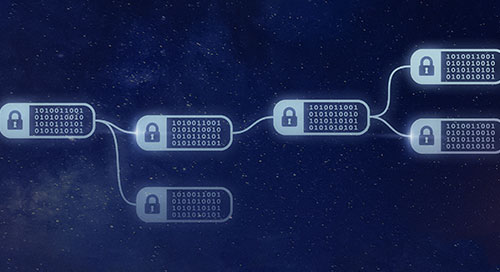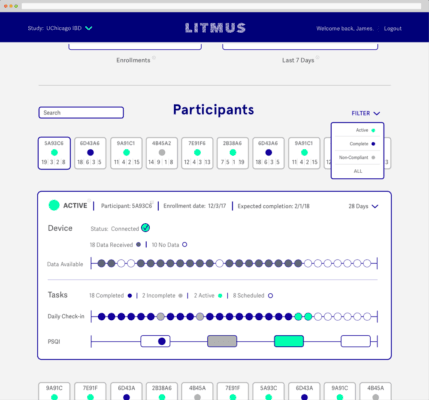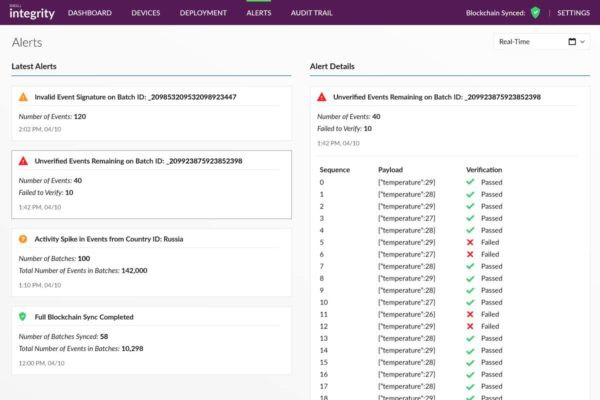When Health Tech Meets Blockchain

For many, blockchain is synonymous with the rise of cryptocurrencies like Bitcoin. But as it turns out, many critical applications that rely on streaming sensor data can also benefit from the data integrity and security afforded by blockchain.
How?
Blockchain is a distributed ledger where many high-performance computing nodes operating on a peer-to-peer network expend resources to validate the authenticity of a given transaction. Once the nodes cumulatively verify a transaction and all of its accompanying data, it is added to a string of transaction records known as blocks—which collectively form the chain (Figure 1).

Each block added to a blockchain is signed with a cryptographic hash from the block immediately preceding it, and that hash changes if someone attempts to alter the data within a block. To manipulate the blockchain, the cryptographic hash of the target block would have to be modified, as well as the hashes of every successive block in the chain.
In theory, this means that highly verified blockchain data can be used to ensure that systems based on automated rules are not acting on corrupt or inaccurate information. And in applications that must comply with data privacy and security regulations, the immutable ledger can almost guarantee that records are not lost or tampered with.
But there are significant hurdles to implementing blockchain in these edge environments. For instance, blockchain nodes usually must be robust enough to store a full copy of the entire transaction ledger. And while streaming data applications often require latencies of less than a second, blockchain transaction verification can range from five to 10 minutes in cryptocurrency use cases.
An Immutable Ledger for Health Tech
These limitations mean that today’s mainstream blockchain implementations are not suitable for streaming data use cases such as the clinical trials enabled by Austin-based Litmus Health.
To blend its application requirements with the immutability, security, and integrity of blockchain, Litmus Health partnered with IoT data automation specialist Sixgill.
Litmus Health offers a technology platform that ingests data from remote patient monitoring devices like smartphones, wearables, and home sensors to help healthcare researchers study conditions like cancer, chronic inflammatory diseases, and so on (Figure 2). Through a mobile application, data from these sensors is relayed to on-premises or cloud-based instances of the Litmus platform in real time.

Despite the resource-constrained devices used in Litmus Health’s operations and the need for low-latency data communications, the application requires qualities that blockchain can deliver.
For example, to weed out trial bias and provide researchers with the most accurate data, acquired sensor readings cannot be normalized and therefore must be treated as individual time-series events. Both the platform and the data it touches are also subject to regulations such as HIPAA and the FDA’s Title 21 CFR Part 11 standard, which govern the privacy, security, reliability, and trustworthiness of electronic medical records. And this requires high levels of data traceability and auditability.
“It’s really an audit trail of the audit trail.” @SixgillTech
Blockchain for Real-Time, Resource-Constrained Healthcare
Sixgill’s Integrity is a device- and data-agnostic blockchain solution designed for time-series data streams. To bring the capabilities of blockchain to applications like Litmus Health, edge systems are equipped with a small-footprint agent. This data is then ingested into Integrity’s hybrid “on-chain, off-chain” architecture.
“We converged on a hybrid architecture where we use horizontally scalable big data technologies just for the data,” said Dominiek Ter Heide, Chief Architect & Vice President of R&D at Sixgill. “We also use IBM Hyperledger as the control layer in our verification process. So for all the data flowing through the system, we do rolling hashes, and we stamp that on IBM Hyperledger.”
More specifically, the “off-chain” component of Integrity is based on distributed queuing, elastic search, and Kubernetes. This allows high-volume, high-speed data streams to flow from Intel® processor-based endpoints or gateways directly into a back-end data platform like Litmus.
Separately, the “on-chain” portion of the solution is built on IBM’s Hyperledger blockchain technology. This layer verifies transactions by applying rolling hashes to sequences of event data. These cryptographic hashes and additional metadata for each transaction are then stored on the Hyperledger.
Finally, the Hyperledger is audited again and each transaction block is placed on Bitcoin’s public ledger (Figure 3).

“It’s really an audit trail of the audit trail. It takes the history of all the different blocks in the Hyperledger and creates another rolling hash of that, and a specific signature that identifies the blocks. And that is then stamped onto the Bitcoin public ledger,” Ter Heide explained.
“It’s almost like a gearbox, where you have different gears of data flow and verification flowing through the system, with the last stop being Bitcoin,” he added.
By implementing this layered approach to data flow and transaction validation, Integrity provides Litmus Health with secure, regulatory-grade data auditability that spans the entire information lifecycle (Figure 4). And it can achieve this with transaction latencies of under a second.

Blockchain Beyond Bitcoin
Litmus Health works with hospitals, large pharmaceutical companies, and other organizations for which data integrity is vital. Mishandled, inaccurate, or corrupt information can lead to lawsuits, medical misdiagnoses, development of ineffective drugs or treatments, and so on.
Here, the need for blockchain-type solutions is clear.
And there’s a broad range of additional use cases that can be empowered by blockchain implementations conducive to low-latency, resource-constrained environments. Almost any critical application that demands high-integrity data to drive automated actions, comply with industry standards and regulations, or for increased security should investigate blockchain.
Blockchain is moving beyond Bitcoin. And your IoT systems can cash in.